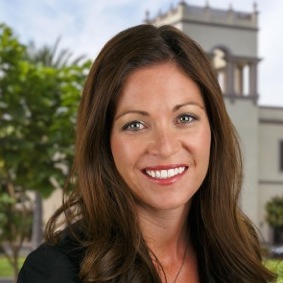When we focus on learners—connecting to their interests, needs, and goals—we can create experiences that ignite curiosity, develop passion, and unleash genius.
We recently caught up with the author of Learner-Centered Innovation and Evolving Education, Dr. Katie Martin.
Q: What experiences have brought you to your commitment to learner-centered education?
Katie: Unlike a lot of teachers, I didn’t go into teaching because I loved school. In fact, it was the opposite.
One experience, in particular, was growing up, we had a gifted and talented education program (GATE) like many schools do. My best friend was always in these classes, and I was not. So, in my elementary and middle school state of mind, it was clear to me that she was smart and I was not. I was also keenly aware of the cool projects and awesome teachers that she had in these programs that I did not.
There were tests that had sorted and ranked us, and I let those results determine what I thought I was capable of—and to be honest, so did many of the adults.
This experience had a major impact on me and drove me to become a teacher. I was committed that my students would understand that their voice mattered and be empowered to learn—not because they needed to know information for a test but because it would allow them access to new ideas and pathways for their own lives.
As a mom, this has become even more important to me. I have seen what I know my children are passionate about and capable of at home and in the world outside of school reduced to simple numbers and grades that don’t capture the whole picture of what they know and can do.
More importantly, I have seen what is possible when they have opportunities to engage in meaningful projects with skilled teachers and a learning community to mentor and guide them along the way. As Zack, my 6th-grade son has shared when I asked him about the stark contrast in his motivation and effort, “It feels so much better doing work that people see or experience, rather than work that gets thrown away.”
Q: What are some of the key experiences you’ve had as an educator that brought you to where you are today?
Katie: I taught 7th and 8th-grade language arts at Ilima Intermediate on Oahu, and those years are still some of my fondest memories.
I loved my students and colleagues, and I was fortunate to have an excellent new teacher mentor who supported me, pushed me, and coached me to be the best that I could be for my students. It was through her guidance that I learned not only to implement effective practices and hone my craft as a teacher, but also to develop the skills of an effective coach.
Another critical component of my early years as an educator was that I was afforded the opportunity to enroll in a certificate program, Teaching All Children Together (TACT), which was based on Universal Design for Learning (UDL). This program allowed me time to collaborate with colleagues, learn effective practices, and meet the diverse needs of my students who ranged from non-readers to those reading at a “12th grade level” and beyond in the same classroom.
I continued on from that certificate program and got my Master’s in Curriculum and Instruction and my Ph.D. focusing on teacher support and development. The opportunity to learn, research, and implement new ideas that I was passionate about has created the foundation of integrating research to practice in all of my work since then.
There were tests that had sorted and ranked us, and I let those results determine what I thought I was capable of—and to be honest, so did many of the adults.
Dr. Katie Martin, Chief Impact Officer, Learner-Centered Collaborative
Q: With the recent release of your book, Evolving Education, can you share more about what inspired its writing and what you are hoping readers will take away from it?
Katie: Education Reimagined’s work and the organization’s way of characterizing the paradigm shift from school-centered to learner-centered was a significant source of inspiration. It is about shifting how we see learners and their critical role in their own learning now, and throughout their lives.
To quote A Transformational Vision for Education in the US — “Learners are seen and known as wondrous, curious individuals with vast capabilities and limitless potential. This paradigm recognizes that learning is a lifelong pursuit and that our natural excitement and eagerness to discover and learn should be fostered throughout our lives, particularly in our earliest years.”
When we focus on learners—connecting to their interests, needs, and goals—we can create experiences that ignite curiosity, develop passion, and unleash genius.
In writing, I also often thought about the Gallup poll that highlighted how student engagement decreases over time. Many educators know this anecdotally. But, when you see the data and its representation in this graph by Scott Mcleod, it is striking.

You see that across the US, as students move from 5th to 12th grade, they have fewer opportunities to pursue an interest in school. They report fewer opportunities for fun, and the lowest scoring of all is students having opportunities to do what they do best every day. Beyond all of this, it is worth mentioning how low these starting percentages are—that as early as fifth grade, over 65% of young people are already not finding the opportunity to do what they do best is remarkable.
In a learner-centered paradigm, I believe it’s not only possible but in all of our best interests to create opportunities where we flip this graph and ensure that learners are doing things that are interesting and fun, and being supported to find and express what they do best every day. If we can engage students in meaningful problem solving, we will help them develop the knowledge, skills, and mindsets to thrive in school and beyond.
As early as fifth grade, over 65% of young people are already not finding the opportunity to do what they do best.
Scott McCloud, Gallup Student Poll
Q: If you were building a learner-centered community from the ground up, where would you start?
Katie: I could go on forever, but I will share what I believe to be three key steps.
First and foremost, I would always urge people to begin with empathy. Too often we design based on our own goals and perspectives and assume we know what others want or need. When we begin with empathy, we open ourselves up to more perspectives and, ultimately, to opportunities to think differently. If we want to build a learner-centered community, we must start with learners and understand their needs.
Second, I would gather a guiding coalition made up of multiple perspectives from young people, educators, administrators, support staff, and community members to engage as learners together. Listen deeply to the voices that represent your community and explore new models to help move past what we have experienced in the past or what we believe school must be.
Third, in education, we are taught backwards design. I’m a fan of this method and know that it helps us to design meaningful experiences to achieve desired outcomes. To build a learner-centered community, however, I would argue that we need to begin with the outcomes that we truly want learners to develop.
In addition to foundational skills and knowledge, we need to think about critical thinking, problem-solving, empathy, persistence, and global citizenship to name a few. Ideally, these outcomes are discussed and agreed upon as a local community. We can start by articulating the desired whole child outcomes, or as some call it, a Graduate profile, to create a shared North Star and then backwards design from there to create the learning experiences and enabling conditions necessary to reach those outcomes.
Q: Acknowledging many educators across the country are limited by some level of constraints within the current standardized system, what opportunities exist to foster learner-centered experiences?
Katie: Agency by definition is the power to act. But, too often, this is misconstrued as a free-for-all. We all operate within constraints, but we don’t have to do things the same way to reach the intended learning targets or goals.
Educators have certain expectations they are accountable for meeting, and there’s a variety of content and skills that we want young people to learn. There can still be opportunities for purposeful learning where young people are engaged and driving their own learning process based on shared goals and expectations.
In order to create opportunities for learners to seek information and learn to learn, I would suggest posting six questions to your young people, aimed at promoting learner agency and encouraging learners to wonder, explore, and drive their learning (yes, even within your content standards):
- What do you know and what do you still need to learn?
- What books, articles, videos, and other resources might help you learn more?
- How does this connect to what you already know?
- What are some creative ways to solve this problem?
- Who are the experts you can learn from?
- How will you share what you were learning?
Teachers who provide exposure, guidance, encouragement, checkpoints, and ongoing feedback are critical to the learning process. Teaching learners how to learn and embrace pitfalls to improve can allow students to deepen their engagement and sense of purpose in learning.
Q: You’ve worked with so many educators and learners. What can be made possible for communities when they embrace learner-centered education?
Katie: As one educator told me, “This is just helping us do what we say we care about and achieve our vision.” Yes, exactly!
If you think about most school visions and the people who create them, they aspire to develop successful and self-sufficient young people who can collectively contribute to a better world. The problem is that our practices and structures are not always aligned with our aspirations or how we measure success.
When we come together, talk about what we really want, and work together to make it happen, we can build stronger communities and foster joy, passion, commitment, and really powerful learning and actions. This is what ultimately will create communities capable of ensuring that each and every individual has the opportunity to learn, grow, and become their best selves.

